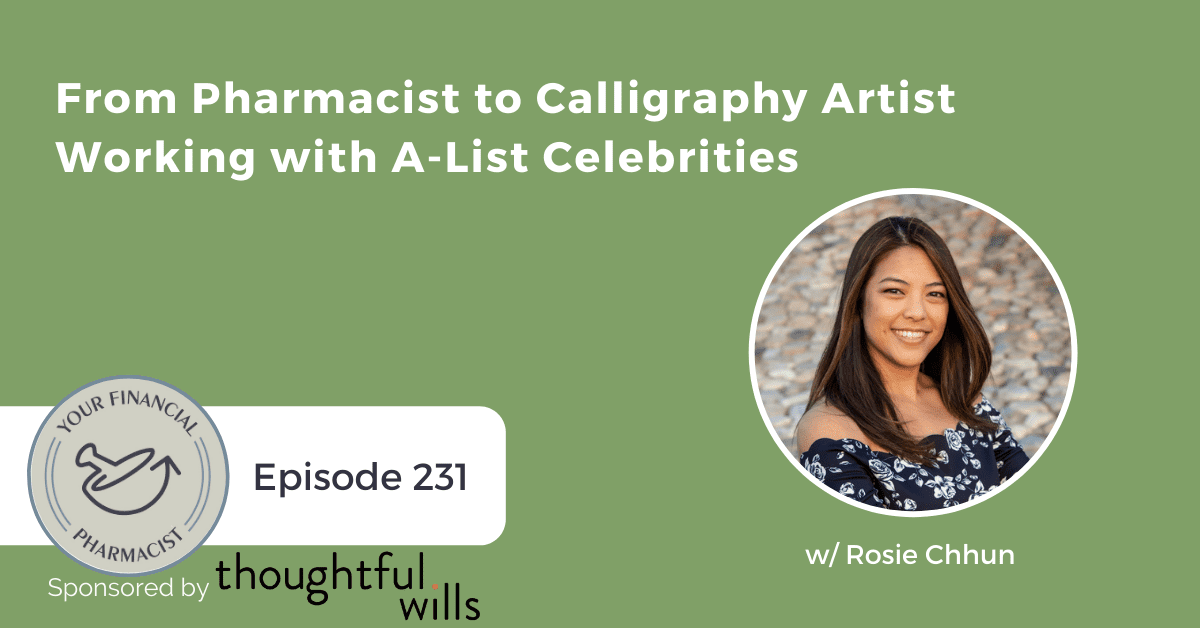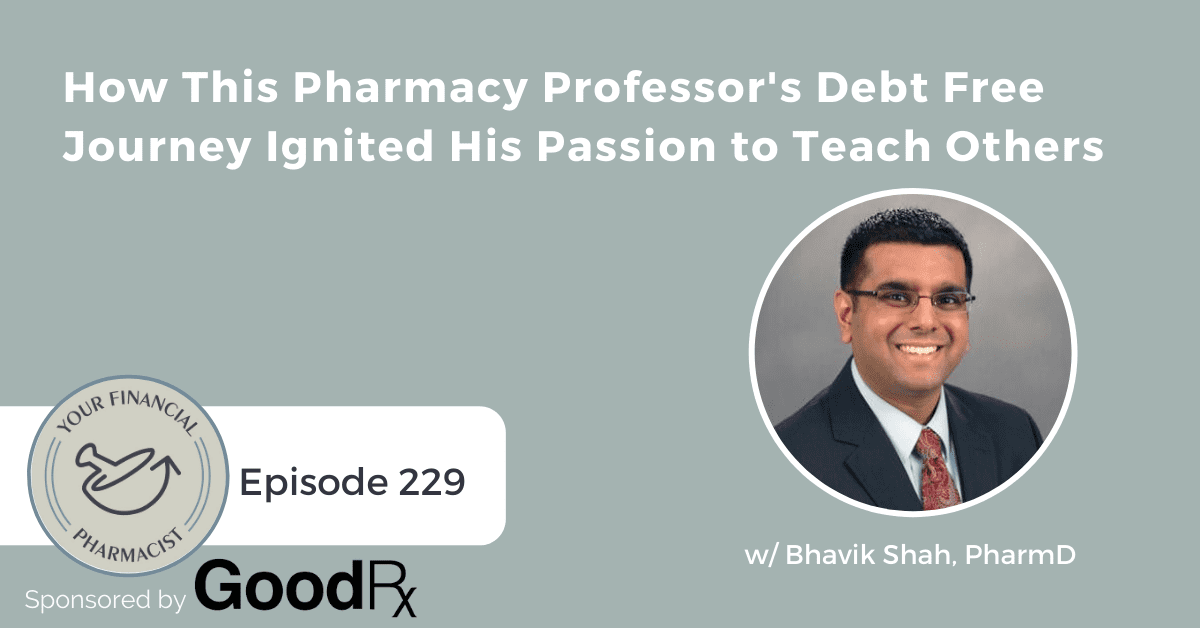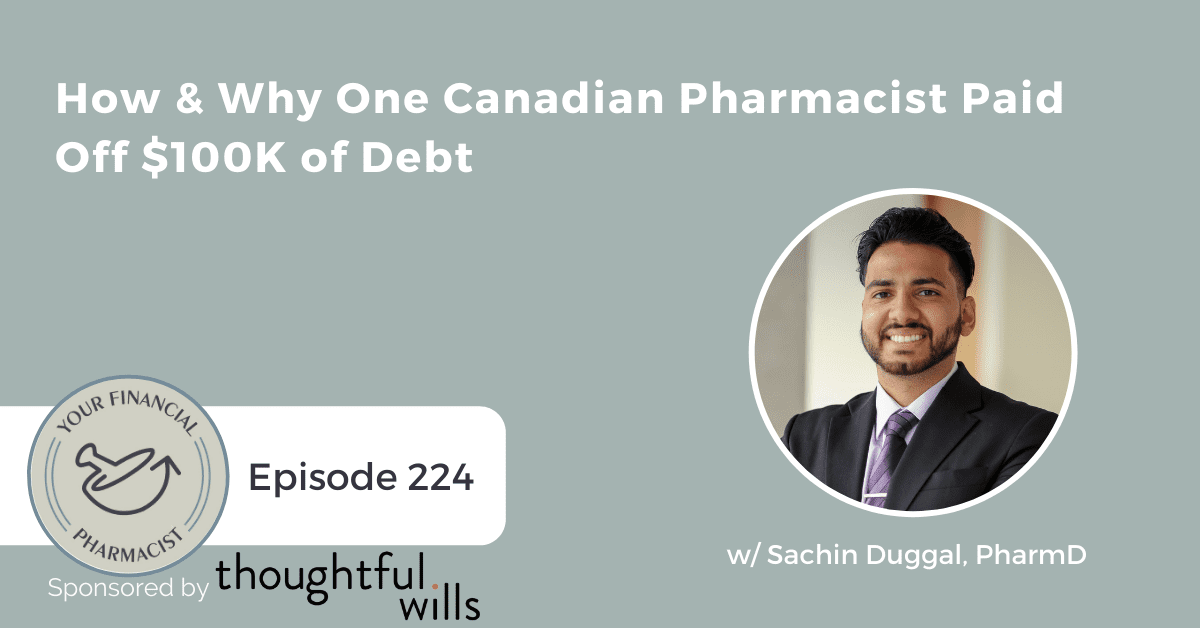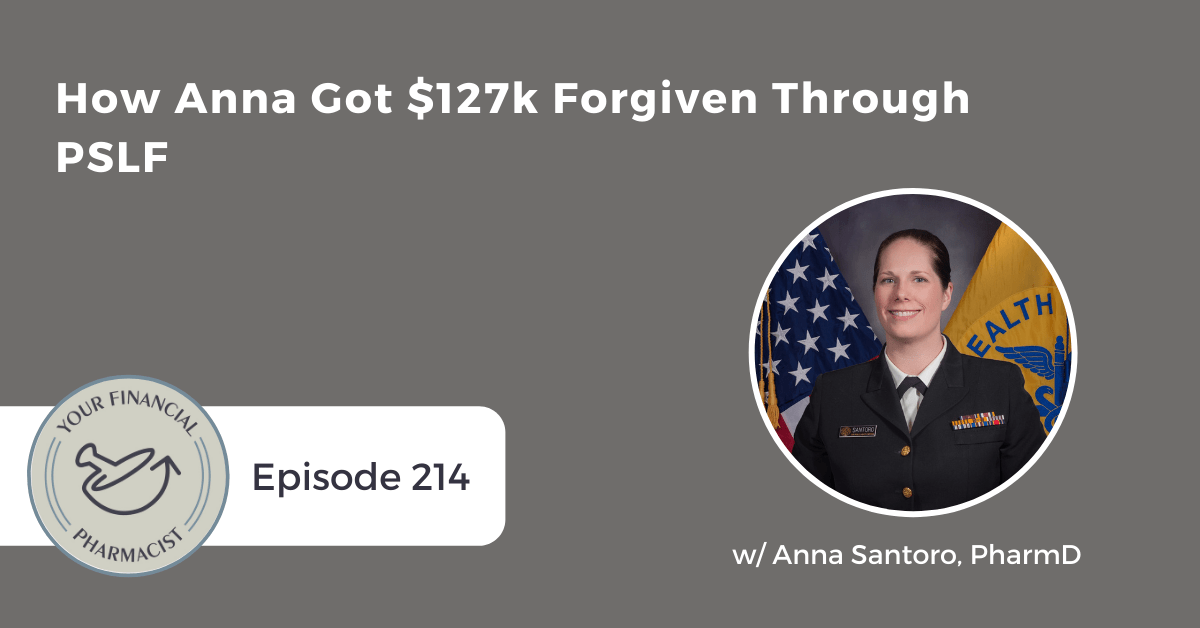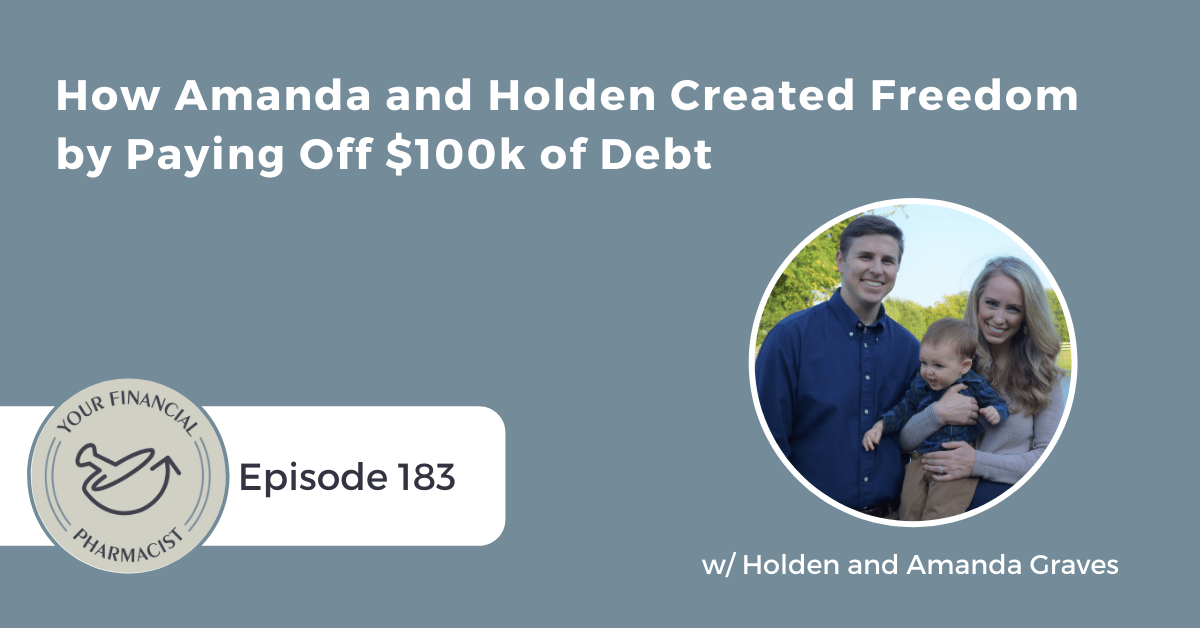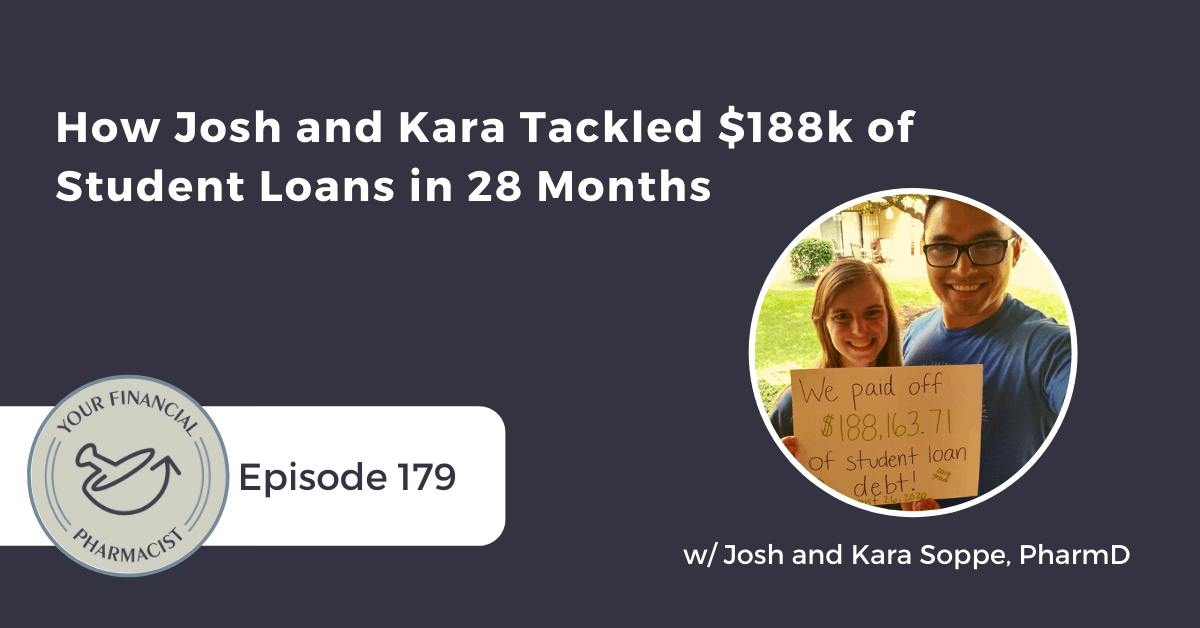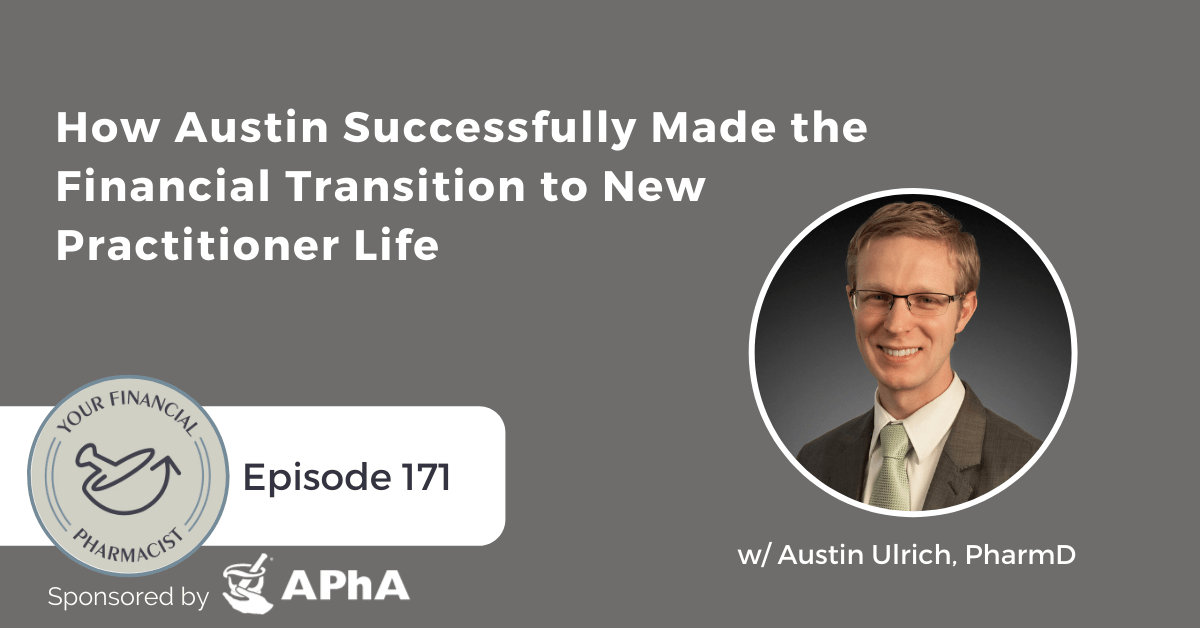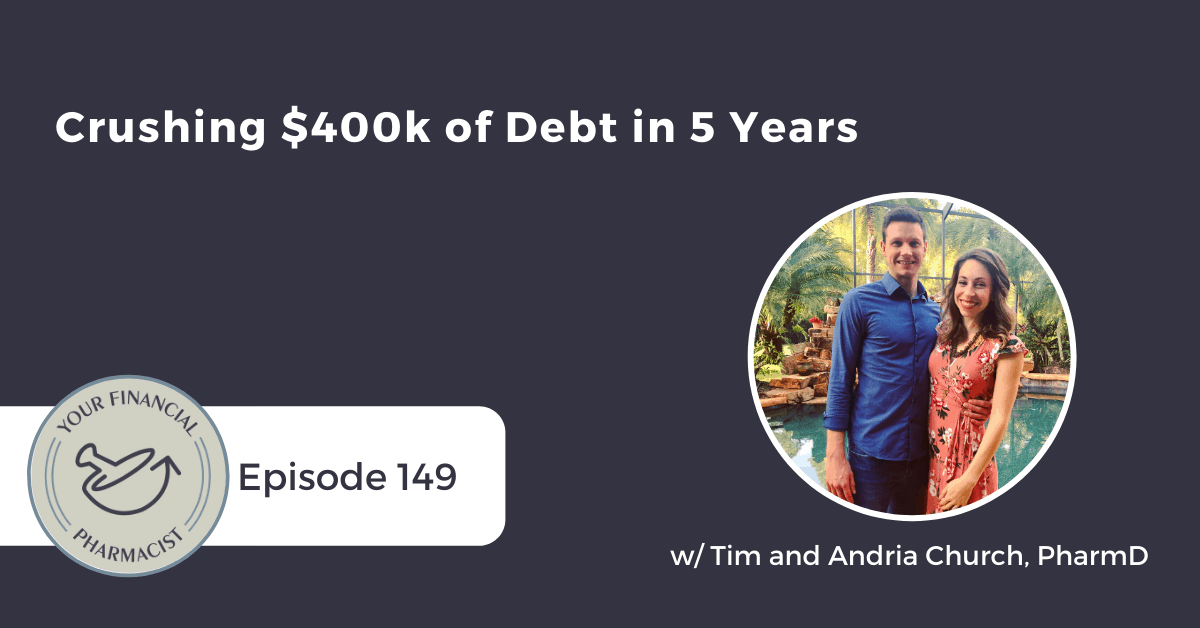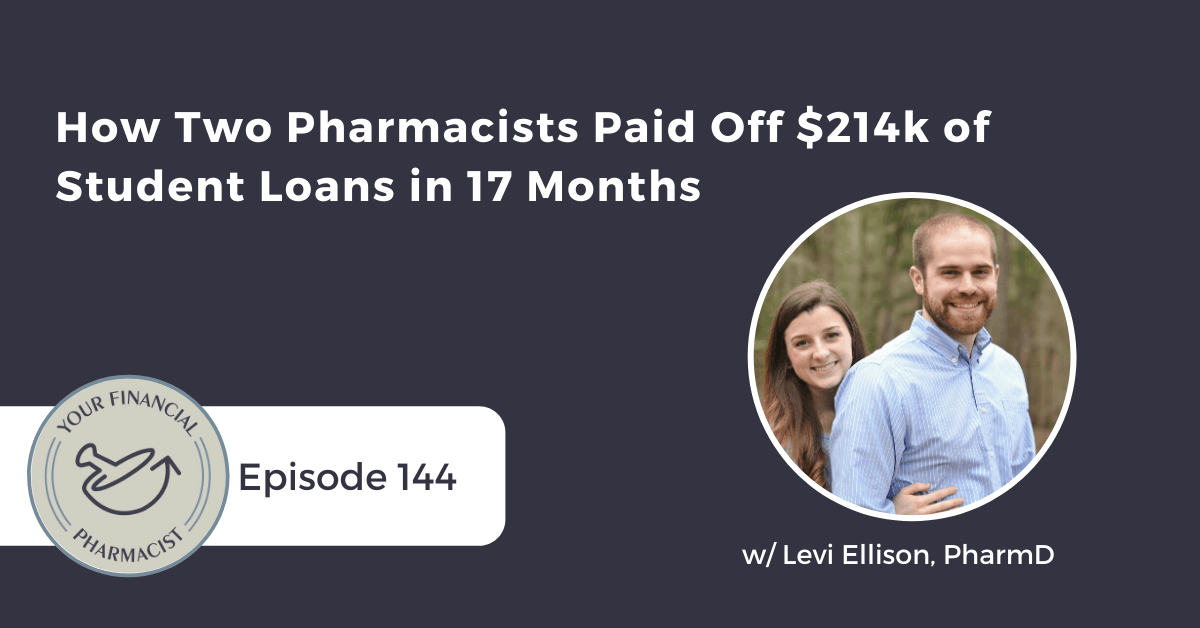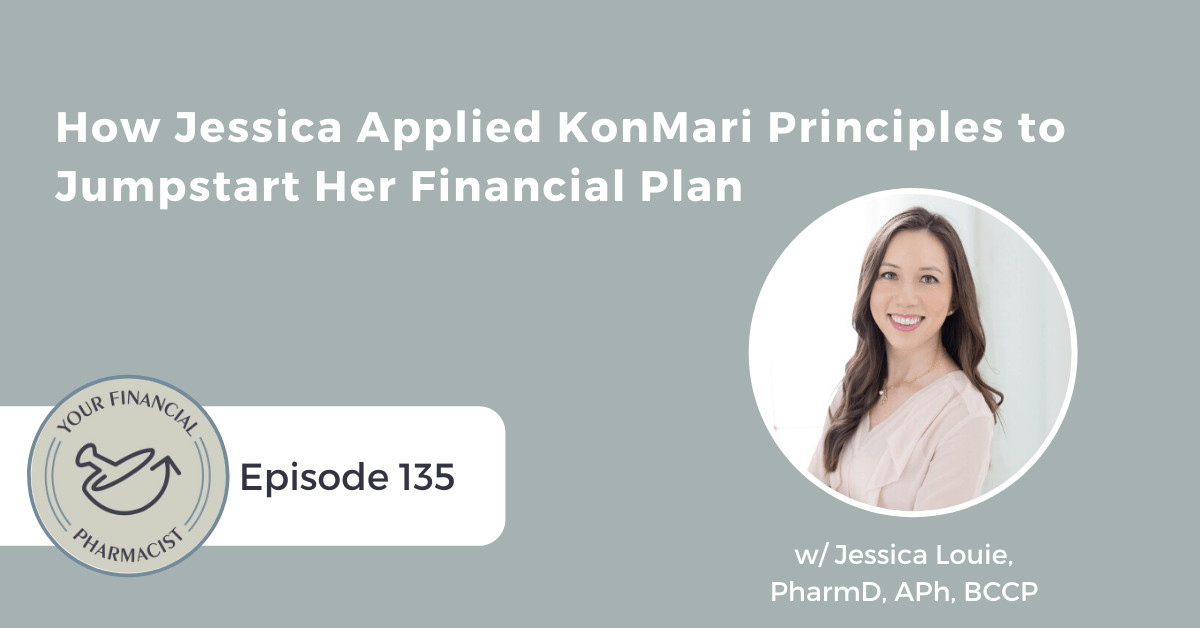From Pharmacist to Calligraphy Artist Working with A-List Celebrities
On this episode, sponsored by Thoughtful Wills, pharmacist and entrepreneur Rosie Chhun, talks about how her side hustle turned main hustle afforded her the ability to pay off $180k in student loans.
About Today’s Guest
Rosie Chhun is a pharmacist by day and calligrapher by night. She is the artist behind Wander Crafter, a calligraphy and engraving company that specializes in live events and brand activations. Her floral calligraphy engravings make her stand out amongst other artists, allowing her to work with A-list celebrities like Jay-Z, Chrissy Teagan, and Kris Jenner as well as brands such as Netflix, HBO, and Neiman Marcus!
After a major downfall of not passing the CPJE and losing her dream residency, she fell into a deep depression and used her art to create joy in her life and pay off her student loans. After 3 really long years of hustling at the pharmacy and the creative business, she paid off her $180,000 debt and is making big moves in her calligraphy career! She just launched a YouTube channel to teach engraving, a calligraphy business coaching program, and is continuing to work with luxury brands.
The secret to success is to get clear on your messaging and create what you genuinely love creating.
Episode Summary
Dealing with an overwhelming amount of student loan debt is a common story that most pharmacists can identify with, but today’s guest took control of her story by turning her creative hobby into a flourishing business that paid off her debt, all while teaching herself to be financially literate along the way! Today, we speak with the resilient and tenacious Rosie Chhun, a pharmacist, calligrapher, and business coach who grew her side hustle into a thriving one-woman business called Wander Crafter. What started as a crafty hobby to help with the slow repayment on her $180,000 student loan debt has transformed into a calligraphy and engraving business that has since caught the eye of clients such as Jay Z, Chrissy Teigan, Kris Jenner, Netflix, HBO, and numerous other luxury brands. In today’s episode, Rosie talks us through her process of experimentation and settling on her successful business model, how she cut her overhead costs to virtually nothing, and the two pillars on which her business was built. Listeners hear about her journey through pharmacy school and into the field, the burnout from the pandemic that pushed her into taking the entrepreneurial leap, and, finally, the deep sense of reward and achievement she gets from coaching and engraving at live events. If you ever wondered how to turn your passion into a reality, then tune in to get your weekly dose of inspiration today!
Key Points From This Episode
- Hear about Rosie’s roots as a pharmacy technician and her journey in pharmacy school.
- Having to re-evaluate how she was moving forward and paying off her $180,000 debt.
- How paying the minimum hardly touched the interest accruing every month.
- How Rosie’s love of calligraphy intersected with starting a business to pay off her debt.
- What galvanized her to take action and become financially literate.
- Reinvesting back into her business every time things were going well!
- Arriving at her successful business model with virtually no overhead costs.
- Just getting started, and continuing to learn and evolve as things go on.
- The two different pillars that make up Rosie’s business: live events and coaching!
- The gradual transition from an expensive hobby to a flourishing business.
- How the stress and burnout of the pandemic was the final motivator to leave pharmacy and commit to full-time entrepreneurship.
- Developing resiliency and not being afraid to take calculated risks.
- Intentionally growing as the demand increases and getting a supportive team.
Highlights
“By paying the minimum [on my student debt], I was hardly even touching the interest that was accruing every month. That was really painful. I realized, even if I had refinanced and did all the things right, I would be in debt for a very, very long time.” — Rosie Chhun [0:08:35]
“Everything is online. I don’t do any additional excess costs if I don’t have to. Really, the only expense that I have right now is gas because I have to get to the location. It’s really nice.” — Rosie Chhun [0:17:36]
“If there’s anyone listening out there, I would say, don’t wait until you’re at an existential crisis to turn your hobby into a business.” — Rosie Chhun [0:25:06]
“There [are] a lot of things that I learned in pharmacy school that I would not have learned out in the real world if I had just entrepreneurship from the very beginning.” — Rosie Chhun [0:27:22]
Links Mentioned in Today’s Episode
- Wander Crafter Calligraphy & Signs
- YFP Planning: Financial Planning for Pharmacists
- Book a free Discovery Call with YFP Planning
- Create a Comprehensive Estate Plan with Thoughtful Wills
- Dave Ramsey
- Craft Academy
- Follow Rosie Chhun on Instagram: @wandercrafter
- Follow Rosie Chhun on TikTok: @wandercrafter
- Rosie Chhun|Wandercrafter Youtube
- Your Financial Pharmacist Disclaimer and Disclosures
Episode Transcript
[INTRODUCTION]
[00:00:00] TU: Hey, everybody. Tim Ulbrich here, and thank you for listening to the YFP Podcast where, each week, we strive to inspire and encourage you on your path towards achieving financial freedom.
This week, I had a chance to welcome Rosie Chhun onto the show, a pharmacist and entrepreneur who owns a successful calligraphy and engraving business called Wander Crafter. During the interview, Rosie and I discuss how her side hustle turned into the main hustle, afforded her the ability to pay off $180,000 in student loans. We also discussed how a couple of difficult scenarios right after the completion of her PharmD led her on the path to starting her own business. Finally, we discussed how her business went from idea to a hobby, to a successful venture that has allowed her to work with A-list celebrities like Jay Z, Chrissy Tegan, Kris Jenner, and brands such as Netflix, HBO, and Neiman Marcus.
Before we hear from today’s sponsor and then jump into the show, I recognize that many listeners may not be aware of what the team at YFP Planning does in working one on one with more than 240 households in 40 plus states. YFP Planning offers fee-only, high-touch financial planning that is customized for the pharmacy professional. If you’re interested in learning more about how working one on one with a certified financial planner may help you achieve your financial goals, you can book a free discovery call at yfpplanning.com. Whether or not YFP Pining’s financial planning services are a good fit for you, know that we appreciate your support of this podcast and our mission to help pharmacists achieve financial freedom.
Okay. Let’s hear from today’s sponsor, and then we’ll jump into my interview with Rosie. This week’s episode of your financial pharmacist podcast is sponsored by Thoughtful Wills. Let’s take a minute to hear from co-founder, Nathan.
[0:01:43] NK: My name is Nathan Kavlie and I’m one of the founders of Thoughtful Wills. Our law firm spends a lot of time thinking about the process of estate planning. There’s no way we can get around the yuck of death. So instead, we focus on being lawyers that you’ll actually enjoy working with. We pride ourselves on being approachable and then we take the extra time to draft documents that are actually understandable. We pair that with technology to make the process cheaper and more convenient. Please visit our website, thoughtfulwills.com/yfp and poke around, then book a meeting with us, please. We are genuinely excited to chat with you.
[INTERVIEW]
[00:02:21] TU: Rosie, thank you so much for joining the show.
[00:02:23] RC: Hi, Tim. I’m so excited to be here. Thanks for having me.
[00:02:26] TU: Well, I am really excited to have you on the show and to talk about your pharmacy and entrepreneurial journey. We recently connected via email where you reached out and shared your story of paying off $180,000 and becoming debt-free, while also building an incredible calligraphy business. I shared this story with the YFP team. They loved hearing about your story and couldn’t wait to bring you on the show to share that story with the community. For starters, congratulations on paying off your debt. We’re going to get more into that here in a little bit. But to get us started, back us up a little bit into pharmacy. Where did you go to school? When did you graduate? What drew you into the profession?
[00:03:04] RC: Yeah. I actually started off as a pharmacy technician back in 2009. I worked in a hospital for about four and a half years while during undergrad and just getting experience. I took a couple of years off and applied to pharmacy school and wound up going to University of Washington and Seattle in 2013. Graduated in 2017 and then started the business around 2018 when I realized I needed something else to really pay off the amount of loans that I had incurred, along with some hiccups along the way, which we can talk about in the future or in a couple of seconds, I guess.
[00:03:41] TU: Absolutely. I want to talk about the debt accrual phase for a moment while you’re in school. I’ve shared on this show before that, in my own journey, paid off a couple $100,000 of debt. The debt was racking up, but I really didn’t think that much about it. It felt a little bit like monopoly money, to be honest and it didn’t get real for me until that first payment came due after the grace period was up, six months after graduation. Talk to us about how you viewed your loans when you’re in school. Was it something that you thought, “You know what, I’m going to be able to pay that off later, not really worried about it”? Or was it in the back of your mind throughout school?
[00:04:16] RC: There was a lot of different phases, I feel like. When I was in school, I definitely had it in the back of my mind and that was one of the reasons why I decided to go out of state. I’m originally from California. I live in Long Beach. I did get into USC at the time, but decided to kind of spread my wings a little bit and try to save up some of that monopoly money, if you will. When I was there, the first year, we paid out-of-state tuition, which was around $55,000, I believe for the first year. UDUB had a program at the time if you wanted to claim in-state tuition, you would have had to work 30 hours per week during school. That’s what my roommate and I ended up doing just to prove that we weren’t there just for school. We ended up working and busting our butts for the whole first year, ended up getting in-state tuition for the last three years.
I think at the time of graduation, I had only incurred about 120k, which doesn’t even sound like that much, right? That’s kind of the average these days. Throughout the whole pharmacy school, I was kept thinking to myself, like, “Okay. I’m going to work in a hospital. I’m going to work for a nonprofit. I’m going to get loan forgiveness.” I put in all of the things in place for me to try to get that loan forgiveness over the 10 years of working at a nonprofit hospital. When I graduated, things didn’t work out. I ended up matching to a residency, which was the residency of my dreams. I was so hopeful for the future and ended up moving back to California for. Didn’t pass the licensing exam and so ended up getting kicked out of the program.
At that point, I was hit with a very harsh reality, because the six months are up. Didn’t have a pharmacy job, didn’t have a pharmacy license and I didn’t really know what I was doing at the time. I had no plan and it was a really harsh slap in the face by reality. I ended up getting a grad intern position at Walgreens, which is very fortunate because there’s not a lot of people who get hired into the company as an intern if you weren’t an intern during pharmacy school. I was very lucky there, the store manager who hired me was very generous, very gracious and I’m really thankful for the opportunity for him to give me the job. After I got hired on as a grad intern, I trained for about two or three weeks, ended up getting licensed very shortly after that, and then have been working as a pharmacist since then.
[00:06:55] TU: So you had the residency of your dreams lined up, which many of our listeners know just based on match, rates and how competitive it is, that is difficult in and of itself. So you’ve got that residency of your dreams lined up and things don’t go as planned. You graduate, don’t pass the licensure exam. Obviously, with that comes the inability to complete on with the residency position. You’re able to get on as a grad intern with Walgreens even though you didn’t work with them previously, which is great. Here you are in a very different position than you thought you would be. I think that’s a great intersection then into the business. You’re working with Walgreens as a pharmacist, you have got $180,000 of debt. And to your comment earlier, when it was at $120,000, you said only $120,000. I think that’s where we’re at as a profession. I mean, the median debt loads are now, for today’s graduate, about $170,000, so it’s become normalized, I think unfortunately.
[00:07:49] RC: That’s incredible.
[00:07:50] TU: Yeah. Where did you start to see the intersection between your debt and the opportunity you had with the business and some of the passion you had around the calligraphy work?
[00:08:01] RC: Yeah. When I started working as a pharmacist, finally started doing the 401k stuff, started to get financially literate. Then it was time to pay off some of that loan. I hadn’t consolidated any of my loans yet. I hadn’t refinanced or anything. At the time, my average interest rate for the $120,000 was between 5.6% and 6.5%. I was accruing a lot of interest every single month. By paying the minimum, I was hardly even touching the interest that was accruing every month. That was really painful. I realized, like even if I had – if I refinanced and did all the things right, I would be in debt for a very, very long time.
There was no way that I could pay off that debt without a supplemental income or a side hustle, so I started doing a lot of research. People started saying “You can make an income with this calligraphy stuff.” I started doing calligraphy while I was in pharmacy school in 2013. That was just as a hobby. I would be jotting little things in the corner of my notes during class, I would be like sketching something instead of studying, like I was in calligraphy all the time.
When I finally realized that I could turn that into a business, that was when I started to do more research about entrepreneurship, what kind of calligraphy field I could get into. I would say, probably around the same time that I started working as a pharmacist, I also started this side gig. I played on pretty much every single niche of calligraphy you could even imagine. I did the cards, I did cake toppers, I did banners, welcome signs, wedding signs. All things calligraphy, I have tried and touched on. It wasn’t until, I want to say January 2020, where I actually found my niche of hand engraving. I combined, basically, illustration skills with calligraphy skills and created these beautiful perfume bottles that create amazing keepsakes that people can take home and keep for generations.
[00:10:25] TU: We’re going to link to that in the show notes. Wander Crafter is the business. I hope folks will check it out. It really is, Rosie, beautiful work and it’s incredible.
[00:10:32] RC: Thank you.
[00:10:34] TU: How you’ve been able to apply that gift that you’ve been given. Now, I have to ask, as a father of four boys, and my wife who home-schools our boys is incredibly passionate that they need to learn how to write cursive. So, as someone who does calligraphy and I suspect loves the art of writing, and I suspect learning cursive is probably really fun for you. What do you make of nowadays when sometimes, we’re taking cursive out of curriculums, right? It’s not something that every kid is being taught nowadays.
[00:11:03] RC: I know, yeah. I like tricking my little five-year-old niece into learning cursive.
[00:11:10] TU: That’s great. That’s great. You refinance your loans, you’re pursuing this side hustle, which is allowing you to make some more aggressive payments. Ultimately, we’re going to get these loans paid off. You mentioned just a few moments ago that you weren’t at a point of being financially literate. It strikes me because as I hear you talk, you’re talking about things like loan forgiveness, and interest accrual, and refinancing. Clearly, you’ve invested a decent amount of time and understanding, more information that has helped you on that journey. Tell me more about what you meant by not getting to a point of financial literacy and ultimately, getting to that point. What was the spark for you that really pursued your own learning on that journey to be able to implement those things in your financial plan?
[00:11:53] RC: Yeah. In pharmacy school, they didn’t really talk about financial literacy. Maybe I chose not to pay attention, because in my mind, it was always, loan forgiveness was the solution. When I kept thinking to myself like, “Oh! There’s no way I’m going to be able to get into inpatient if I don’t have a residency.” I think having been in the hospital for nine years, four years of technician and four years of pharmacy school interning, and along with the six months of the residency, I think it kind of just left a bad taste in my mouth too. I just didn’t really want to strive for that anymore, and so I figured, retail is probably the easier way to go, so let’s just do that.
I never really tried super hard to understand, or even learn how to do investing or any 401k stuff, or real estate. Anything like that, I just kept thinking like, I’m not there in my life yet. Because as a student, there’s no way I can make any kind of investment. I just kept thinking like, “I’ll learn it later. I’ll learn it later.” It wasn’t until like, I started working as a pharmacist, got my first figural check, and then had to throw all of it to the loans that I had ignored for six to eight months. Then I saw the big number and was like, “Okay. If I can put $3,000 into this per month, how long is it going to take me to pay it off.” It wasn’t touching it. It wasn’t doing anything. I was like, “Okay. I got to do something about this.”
I started listening to you. I started listening to Dave Ramsey. I started reading a lot, and just having the conversations with friends, and family and asking other mentors and colleagues how they were doing it. That really helped me to kind of build that knowledge base so that I could drop it down faster.
[00:13:49] TU: Yeah, education plus action is power, right? As I hear, you really taking that priority to learn more and then to implement that. And obviously, that ultimately pays off as you’re able to knock out that $180,000 of debt when it’s all said and done because of interest and so forth that accrues when you’re talking about interest rates between 5.6% and 6.5%. Yeah, I mean, it’s crazy. I think that’s the piece. I was speaking with a group, actually, this weekend, and really just highlighting to them that it’s not just that debt that’s occurring from semester to semester, year to year, but you got to factor in also the interest that’s going to accrue over the life of the repayment.
Perhaps it gets decreased through something like a refinance, but it’s a great example where having a plan A, B and C is probably a good idea. Because if folks are thinking loan forgiveness or a certain path, and for whatever reason, that doesn’t work out. What’s the game plan, right? What’s the plan to be able to ultimately knock out that debt?
Tell us, I’m curious as a business owner, often when you’re trying to get a business off the ground, there’s this decision to be made of as you start to see some success. Do I take this money and continue to invest back in and grow the business or do I take this money out as an owner and perhaps apply it towards a goal, such as you are here paying off your debt? As you’re growing your business, as you’re making progress in your debt, tell me more about that decision where you said, “You know what, perhaps I could put this money back in the business and continue to grow. But I’ve really got to focus on the loans.”
[00:15:17] RC: Yeah. I started the business in 2018, tried and failed a bunch of things. We bought the Cricut, which is vinyl. Basically, it’s a little computer that can cut vinyl for you, or fun little paper shapes and stuff. That’s how we kind of started. Then we upped our game and bought a Glowforge, which is a laser cutter. That one’s really cool, because you can cut out shapes with wood or acrylic and little things like that. That was really fun, but that was also a really big investment, especially from – I definitely pulled from my pharmacist salary for that. And just continue to reinvest into the business until I started to really run the numbers and figured out what was truly profitable.
It wasn’t until January of 2020, where I took a hand engraving class from one of my calligraphy mentors and we just hit it off. I loved doing all the hand engraving stuff. Eventually, I figured out a business model where I don’t actually have to supply any of the overhead. With the Glowforge, you have to buy wood, acrylic, and you know all the different colors, and you have to do listings and shipping. It just ended up getting up into all of our profits, and we were making very little for a lot of work. Eventually, with the hand engraving stuff, I created a business model where my clients would actually buy this physical item and send it to me. I would engrave it so I would provide the service, and I would mail it back to them or meet up with them to do a local pickup.
I cut out all the overhead cost and I cut all the shipping. Well, most of it. I still ship every so often. But for the most part, my clients are local, and they can drop by my studio and pick up the engraved item. I ended up cutting out so much of my overhead costs. Now, all I have to do is, I have my supplies already all in one kit. I spend maybe like $10 on nib, like my kit. I’ve already invested maybe like $600 or $700 worth for the machine, and the lights and everything that I need to go on site and engrave for clients in person at events and stuff. Really, I just have a room in my apartment, which I call my studio now, and everything is online. I don’t do any additional excess costs if I don’t have to. Really, the only expense that I have right now is gas because I have to get to the location. It’s really nice.
[00:17:48] TU: That’s a great example, Rosie of often, when I talk with folks that have an idea, there can be some paralysis of trying to think about exactly what is the next step or what might this look like in three or five years. One of things I like that you shared is it took some time, right? You had several different products that you worked through, I suspect in three years, you’ll look back today and say, “Oh, I’ve learned this and this and this now that I’ve had a few more years of experience.”
You’re talking about things like some of the operations, and the equipment, and the overhead. Those things can be so overwhelming at the beginning of an entrepreneur’s journey. But what you did was you got started, right? You had an interest, you had a talent, you had a passion, you had a motivation, which obviously here was paying off that debt. You took that first, sometimes very overwhelming but very important first step, which is, get started and then continue to learn and evolve as things go on.
[00:18:39] RC: Right. Yeah, you just figure it out.
[00:18:41] TU: Figure it out. Right. Exactly. Tell us more about the products specifically or a couple of your main products that you offer at Wander Crafter, and who are the customers. You mentioned some local things and so forth. As you think about your business, the products that you have to offer, the folks that you’re focused on marketing those products towards. Tell us a little bit more about those two things in the business.
[00:19:04] RC: Sure. I have two different pillars that make up my business these days. The first one is live events and that includes luxury brands like Neiman Marcus or Netflix. I’ve also worked for HBO Max a couple of weeks ago for their succession launch. Those luxury companies end up bringing me into the store. Going on-site, and I bring my kit and get dressed up and I create a luxury service for these brands to create a better client experience, and that helps them to sell their products a little bit better, because everyone wants something personalized. There’s nothing more special than seeing your name on a perfume bottle.
Most of the things that I do these days are personalization on mostly perfumes. I’ve done it on like whiskey bottles, water bottles and a couple other stones and things like that. But it is mostly perfumes, just because I think that’s where they have the most profitability.
The other pillar of my business is coaching. After figuring it out for a couple of years on my own, I decided to create a coaching program for calligraphers who want to break into the luxury brand industry. I help them start a business, get over the money mindset. How do you charge for something like this, working on a website, or SEO, photography, videography, and leveraging your social media to create a business model that works for you and helps to bring in multiple clients. Not just luxury brands, but also your local clients as well.
Nowadays, I don’t really do the local clients as much. I tried to focus more my attention on the luxury brands just because that has a bigger return for the time that I put into it.
[00:20:58] TU: Very cool. I hope folks will check it out, wandercrafter.com. We’ll link to that in the show notes. You can see more of the work that Rosie’s done, the engraving, the calligraphy as well as the training program. She’s mentioned the Craft Academy and some items to shop there as well. It is really, really beautiful stuff.
One of the things, Rosie, I like to prod a little bit is, you mentioned before we had hit record that, your pharmacy job was funding a very expensive hobby or business. I think for many folks that are getting started with something, especially something they’re very passionate about, which I think links well to the work that you’re doing here, is that, there’s a mindset shift that happens from, “Okay. I’m going to do this thing that is interesting, it’s a hobby to actually running this like a business.”
What was the transition or the pivot point? Was it the specific markets when you mentioned kind of working with some of the higher end items or the training course? Was it figuring out the messaging or the SEO? What was it that really allowed you to make that transition from a hobby to actually running this as a business?
[00:21:59] RC: Oh my gosh! That’s a really good question. I think the transition, business-wise, I don’t know if there was like an actual, pivotal moment. It was more of a gradual, uphill climb. Until, I mean, to be honest, I think it was just a burnout. I don’t know if I ever mentioned this in any of the emails and stuff that we’ve had back and forth. But during the pandemic, I’m sure you’ve heard a jillion times, it was really hard. The initial panic was really difficult. Because we had to tell doctors like, “No, we can’t give you this Z pack” or tell this family, “I can’t give you 20 Z packs. One, I don’t have any, and two, that’s illegal.” It was a lot of moral decisions that I didn’t have to make before. And then, we kind of got used to that with the mail orders and things like that.
Then the vaccines launched to the public in March of 2021. Honestly, that to me, that was the turning point where pharmacy went from a passion to just painful really. At that point in the business, I was already making probably the same amount as my pharmacist salary. For whatever reason, whether it was feeling guilty for giving up on pharmacy or a duty to help the public or family expectations, I just didn’t have the bravery to really just trust myself with the calligraphy business.
It got to a point where we were doing 30 to 60 vaccines per day, and most of the time, we were by ourselves. It was just one pharmacist for the whole day. It just got to a point where I was completely burnt out. I hated my life. I hated work. The only thing that provided a little bit of light was my business. I just remember like one Friday, I was short on technician and we did 30 vaccines that day. Then Saturday, we did the same thing. At the end of Saturday night, I told my tech, “I can’t do this anymore. I don’t think you’re going to see me Monday.”
Monday came around, I woke up and there’s just this existential dread in my day and I just could not physically get out of bed or go to work. So I ended up calling my scheduler and was like, “Hey! I just don’t feel good today.” I called my doctor and I was like, “I think I need therapy.” Like I’m at a point where I could hurt myself. I could hurt my patients because of not being in it. I wasn’t passionate about it anymore. I went to therapy for a couple of weeks and ended up just double downing on my business, my coaching program, my calligraphy business. From there, it blossomed, it grew beyond what I could even imagine. I mean, if there’s anyone listening out there, I would say, don’t wait until you’re at an existential crisis to turn your hobby into a business.
[00:25:15] TU: Yeah. I hear a big mindset shift that happened. I certainly don’t want to say that there have been positive things related to the pandemic. It’s been a very difficult time for obvious reasons. But here, as you share that story again, for you in that journey and some of that pain that you experienced, personally led to further pursuit of the passion that you’ve had around this work. I hope folks would even go back and listen the last three minutes because, Rosie, like your tone in your voice and your enthusiasm around talking about the business relative to sharing, and I could tell, even self-reflecting on some of my own journey for you. Just a very different vibe, and your voice and your tone.
I think, for folks that are listening that have an idea, whether it’s within pharmacy or something else, whether it’s within the job they’re in or pursuing something as a side hustle, or another opportunity, taking some type of a risk or opportunity that they can pursue. Like having folks around you, whether that’s family, friends, accountability partners, you mentioned providers that were involved that hopefully can pick up on some of those passions, and some of the enthusiasm, some of the things that they’re observing and keep you accountable in that journey as well. Resilience, Rosie is something that really stands out to me as I think back to your sharing of some of the difficulties after graduating from pharmacy school and not passing the licensure exam right away, delay, unable to do that residency. How did that journey and developing resilience through that experience in pharmacy, how has that helped you in the business?
[00:26:44] RC: I think it’s just not being afraid to take risks, calculated risks. Being a pharmacist, I think you do have a little bit of type A, doesn’t matter what kind of personality, but there’s a little bit of OCD in there, and just doing whatever it takes to survive and succeed. I think just being able to – even in pharmacy school, I feel like I learned a lot of skills, whether it was learning how to study, and multitask and manage your time. I think there’s a lot of things that I learned in pharmacy school that I would not have learned out in the real world, if I had just entrepreneurship from the very beginning.
Then even working at a retail pharmacy, I think part of that even comes – that taught me a lot too. Working in retail is really hard. You have to be able to multitask, and manage people and teach people in a way that they will understand, whether it’s different teaching, or learning skills and stuff like that. There’s a lot of things that I still learned working out in the real world and going to pharmacy school that I do apply to the business itself as well.
[00:28:01] TU: One of the things you mentioned, Rosie, before we hit record. We’re recording on the first of a month, and you mentioned you had a really big order come in over the weekend, which is leading to a busy Monday and start to the week for you, which is good problems. But problems nonetheless, when you’re growing, and running a business and you have growing demand and more people want your service. We’ve all heard many stories where sometimes businesses may not keep up with some of that growing demand. Talk to us about, as we look ahead at Wander Crafter, as your products, your services, your time is becoming of greater demand. How are you growing the business intentionally? What steps are you taking knowing that there’s going to be demand that continues to increase? At the end of the day, there’s only one Rosie.
[00:28:49] RC: Yeah, that’s a really good question. I was really literally just thinking about that this morning. How am I going to continue scaling this if I’m the only person who can do the engraving, and the writing, and all that good stuff. Right now, I’m just a one-woman business. I did have an assistant who ended up getting her dream job a couple of weeks ago, so I lost her and I’m really sad about it. I haven’t quite recovered from her leaving me just yet, so I am very hesitant to bring on anyone into the business, whether it’s for social media management or even just assistants, or photography, or anything like that. I am very scared to bring someone on in case someone leaves me again. Maybe you can give me some advice on how to grow your team.
[00:29:39] TU: It’s a work in progress. I feel like it’s one of those things that as you are so passionate about the vision, that you obviously are, and as people really treasure the products that you’re putting out, sometimes you as the business owner, me as the business owner can become the bottleneck of the growth. It’s a hard thing. It’s a hard thing to figure out of making sure that you’re comfortable in that next step, making sure that the quality of the product is to the standard that you want it to be.
But also recognizing that the addition of a team and folks that you trust can ultimately mean a bigger reach and the impact that your work can have. I look forward to watching some of the growth and what happens over the next year or two as you continue to grow in that area.
[00:30:23] RC: Yeah, I’m really excited for where Wander Crafter is going too, the coaching program is taking off, the calligraphy portion of it is taking off too. There’s definitely a high need to hire somebody to take some of that load off so that I can have some kind of a balance in life. But right now, I feel like it’s okay. I’m only working like maybe 20 up to 30 hours a week, which is still less than what I was doing with the pharmacy job, so it’s not too bad.
[00:30:54] TU: And pursuing something that you’re really passionate about, which is awesome. Where can folks go, Rosie to follow your work to learn more about what you’re working on?
[00:31:04] RC: Yeah. I am always on Instagram, so head on over to instagram.com/wandercrafter. I’m also getting really big on TikTok these days, so find me there as well. Also just go to my website, wandercrafter.com. You can find out about the Craft Academy, which is the calligraphy coaching business or program rather. And yeah, just hit me up on Instagram. I’d love to chat with you and maybe give you some inspiration for your own business as well.
[00:31:31] TU: Great stuff. We will link to those in the show notes, the Instagram, the TikTok, the website, the YouTube channel. Really appreciate, Rosie taking time to come on the show to share your journey, and hopefully it’s going to inspire many other pharmacists on their own journey. Thank you so much.
[00:31:43] RC: Of course, Tim. This is a dream. I’ve been listening to you for so long. This is really an honor to be on here.
[00:31:49] TU: So fun. Thank you so much.
[OUTRO]
[00:31:51] TU: Today’s episode of Your Financial Pharmacist podcast was sponsored by our friends at Thoughtful Wills. If you haven’t created your estate plan yet, we urge you to reach out to Notesong and Nathan. They draft custom estate-planning documents like wills, trust, healthcare directives, and durable powers of attorney that fit your situation and reflect your wishes. This is key. These are custom legal documents created and reviewed by actual attorneys.
Thoughtful Wills created two cut-to-the-case packages designed for pharmacists who are ready to get their estate planning in order. You’ll really appreciate their dedication to approachable lawyering and they charge about half of what most law firms charge for the same documents. These documents are such a gift to your loved ones. If you haven’t created them yet, please just get it done. Reach out to Notesong and Nathan by going to thoughtfulwills.com/yfp. Go ahead and book a meeting with them. They’ll take such good care of you.
As we conclude this week’s podcast, an important reminder that the content on this show is provided to you for informational purposes only and is not intended to provide and should not be relied on for investment or any other advice. Information in the podcast and corresponding material should not be construed as a solicitation or offer to buy or sell any investment or related financial products. We urge listeners to consult with a financial advisor with respect to any investment.
Furthermore, the information contained in our archive, newsletters, blog post, and podcast is not updated and may not be accurate at the time you listen to it on the podcast. Opinions and analyses expressed herein are solely those of your financial pharmacist, unless otherwise noted and constitute judgments as of the dates publish. Such information may contain forward-looking statements which are not intended to be guarantees of future events. Actual results could differ materially from those anticipated in the forward-looking statements.
For more information, please visit yourfinancialpharmacist.com/disclamer. Thank you again for your support of the Your Financial Pharmacist podcast. Have a great rest of your week.
[END]
Current Student Loan Refinance Offers
[wptb id="15454" not found ]Recent Posts
[pt_view id=”f651872qnv”]

